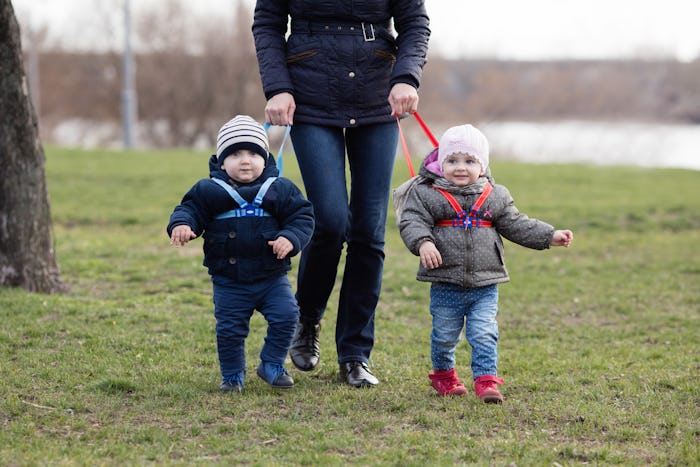Life

Before I had babies I was ridiculously judgmental about parents who put their kids on a leashes. "What do they think they're teaching their kids by putting them on leashes?!" I would say to myself, incredulously and as I looked down from my high horse. Now that I'm a parent, though, I'm confident I can explain the things you're teaching your kid when you put them on a leash.
Eventually, my babies became toddlers and my judgment faded as a whole new world of terrifying possibilities came into view. The boundaries of these possibilities were limitless, which included but were certainly not limited to: the possibility of my wandering toddler getting run over by a car, the possibility of my curious child getting squished by a life-sized Thomas The Tank Engine, and the possibility of me and my pregnant belly not being able to keep up with my toddler and, as result, they end up getting lost.
Because my toddlers were prone to wandering, my partner and I had a really hard time leaving the house with all of our children in tow. In fact, we were kind of housebound for at least two years. Being confronted with the question of "to leash or not to leash" was one of the first times I realized that sometimes you've got to make a decision that is truly best for your family and regardless of the optics. Besides, putting my kid on a leash actually allowed me to teach my kids a few valuable lessons, including the following:
Their Safety Is Important
More important than the snide remarks of passersby about my child being on a leash.
It's not safe for me to let a kid with a propensity for wandering to just walk towards traffic or whatever else. It's also not fair to either of us to stay home until my kid can learn not to wander when we're all in public.
Their Aimless Wandering Is Not Safe
When a child is 1 or 2, wandering is inherently unsafe. My child, who was eventually diagnosed as autistic, has always been a wanderer. Even at 18-months-old, my kid preferred to walk for miles rather than play on the playground. They gave up the stroller as soon as they could walk and would walk until utter exhaustion. Like a shark, they never sat still and couldn't process the dangers of wandering out into the street, wandering in front of shopping carts, or wandering directly into a passersby. Putting them on a leash helped teach them that wandering without restriction wasn't safe and, as a result, wasn't allowed.
They Need Appropriate Boundaries
By putting the leash on my kid I was not only teaching them that wandering was not safe, but also teaching them age-appropriate boundaries. "I love that you want to walk and run for days, sweetheart, but as a toddler you have to stay by mama." I mean, who can disagree with that?
As parents we're always using safety measures until the kid is ready and able to keep their own age appropriate boundaries. A few examples include:
- outlet covers, until they have impulse control to keep their fingers out of the holes;
- cribs, until they won't fall out of the bed or wander around the house at night; and,
- diapers, until they're developmentally ready for bladder and bowel control.
They Don't Want To Get Run Over
Because, seriously, a little leashing hurts a lot less than being squished by a car.
They Don't Have To Panic
You guys. When my eldest was younger we barely left the house because they had so much difficulty with the stimulation of the outside world. All outings would invariably end up with a sobbing, snotting, screaming meltdown or a constant frantic scrambling to make sure they didn't run into traffic, get lost in a big box store, or run head-on into other people's carts. In other words, outings were the worst.
Leashes helped me and my child enjoy our outings. I knew they couldn't go into danger areas, and they didn't have to be encumbered by holding my hand. Hand holding might not seem like too great a burden for a child to bear, but or someone with severe sensory integration challenges, like my oldest, having to hold a hand is an additional level of sensory input that contributes to overwhelm.
I wanted my kid to know that outings didn't have to be scary and frantic. Leashes helped them not be.
They Need To Listen
When I say, "You've gone far enough" I'm not trying to cramp my kid's style. I'm trying to keep them safe. It's a safety issue. Above everything else, my duty as a parent is to first keep my kid safe. So if my kid can't listen, for whatever reason, I will find other ways to contain them within safe boundaries. If my kid didn't like the leash, learning to listen to instructions would cease my usage of the leash.
But, honestly, my kid loved the leash. They even picked it out themselves.